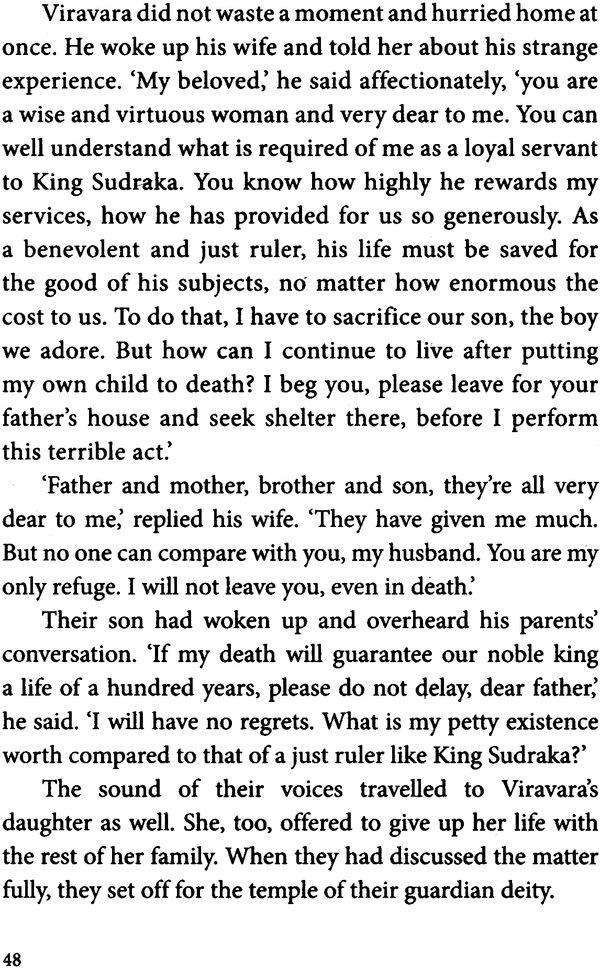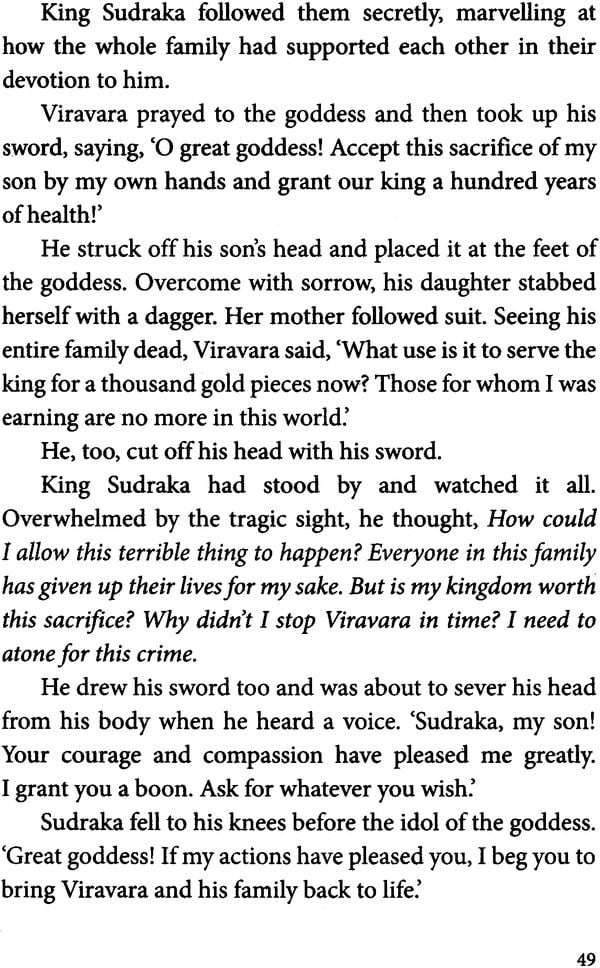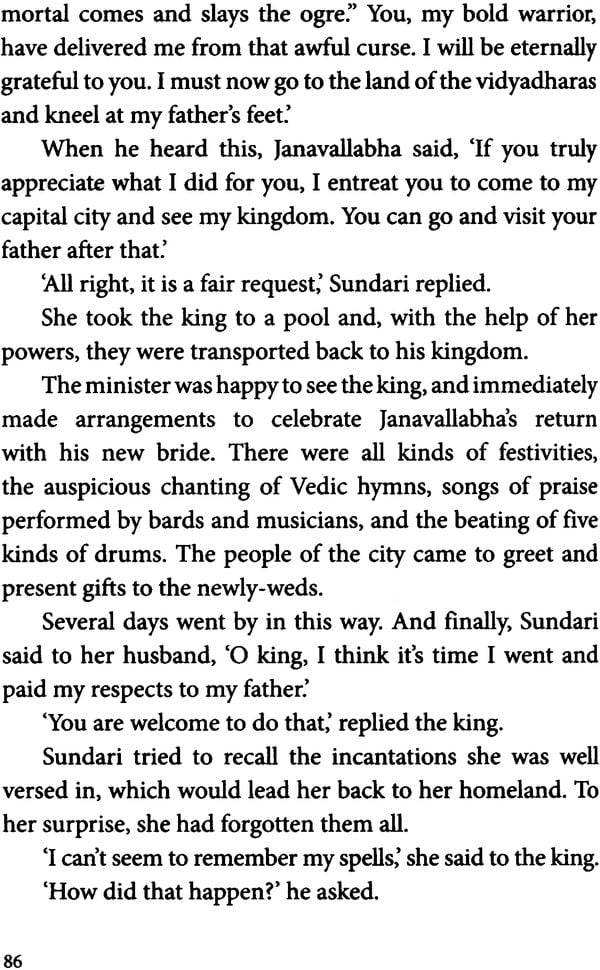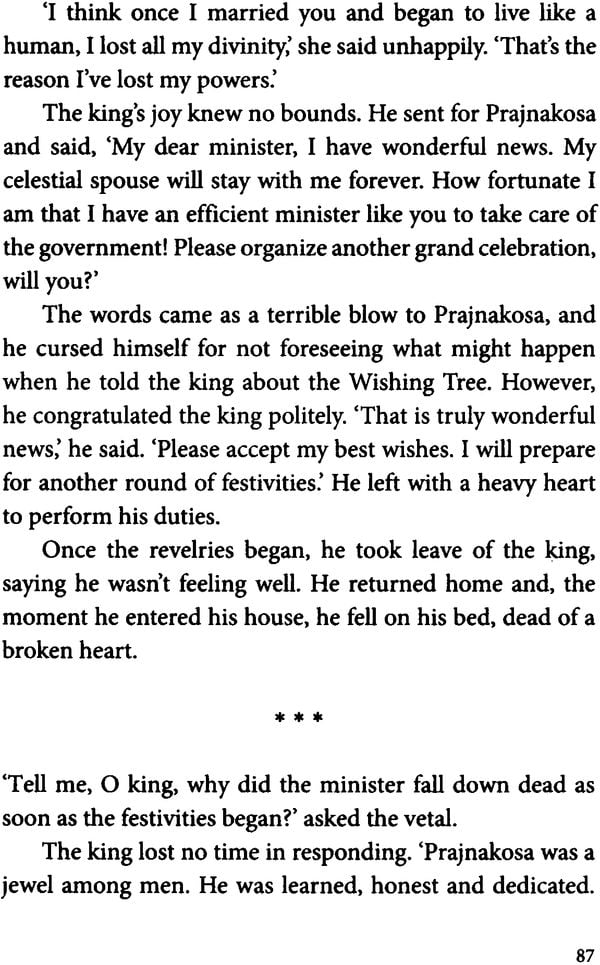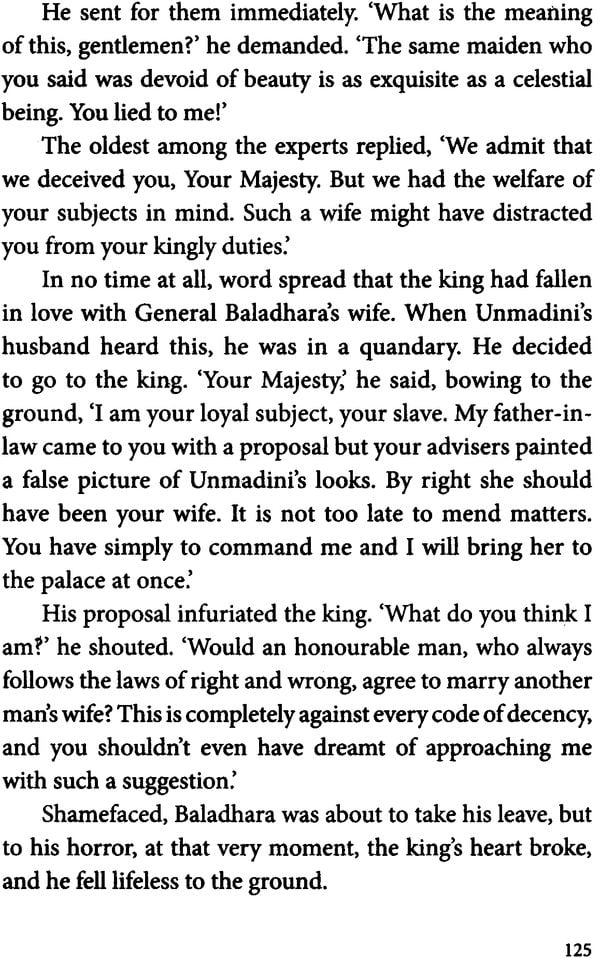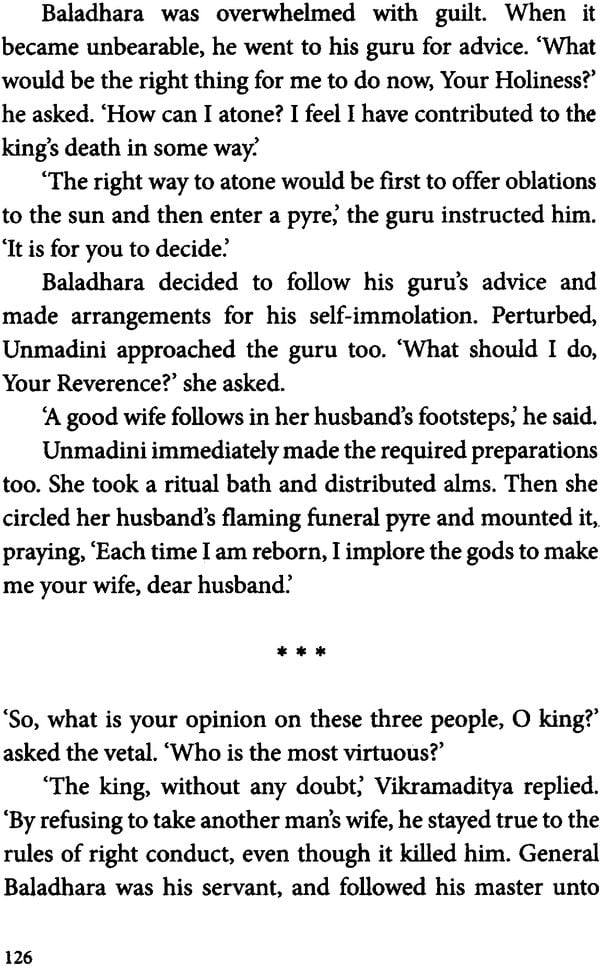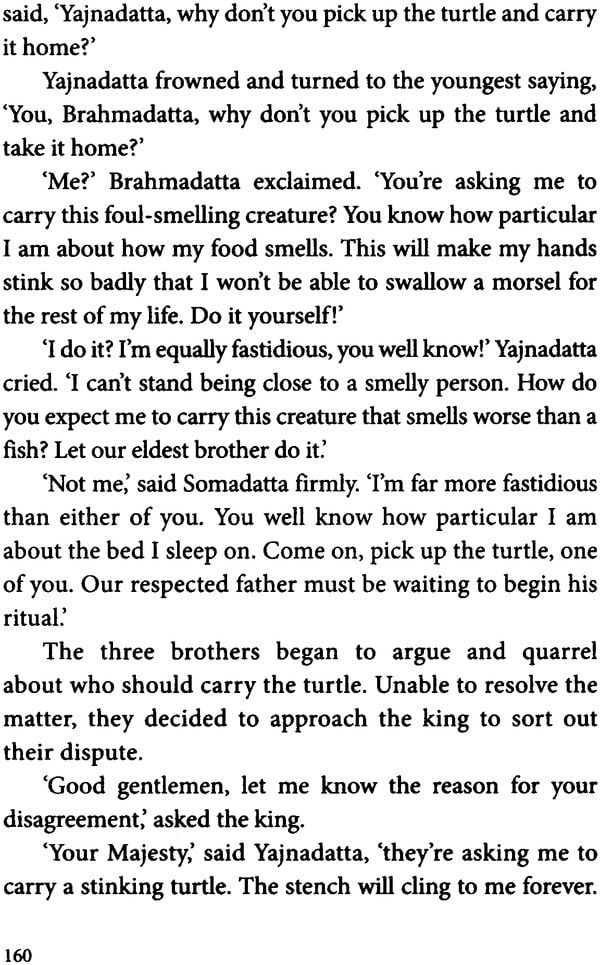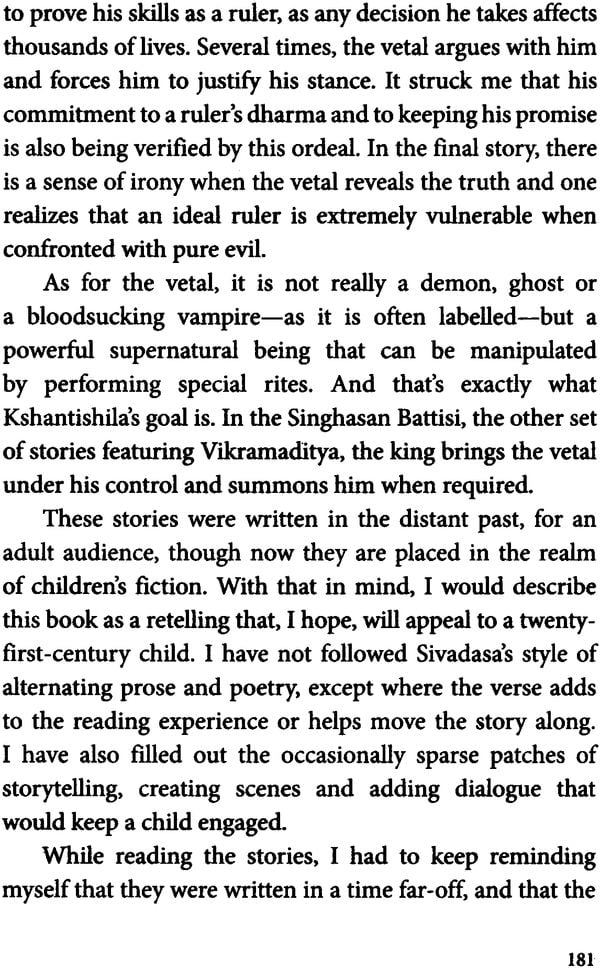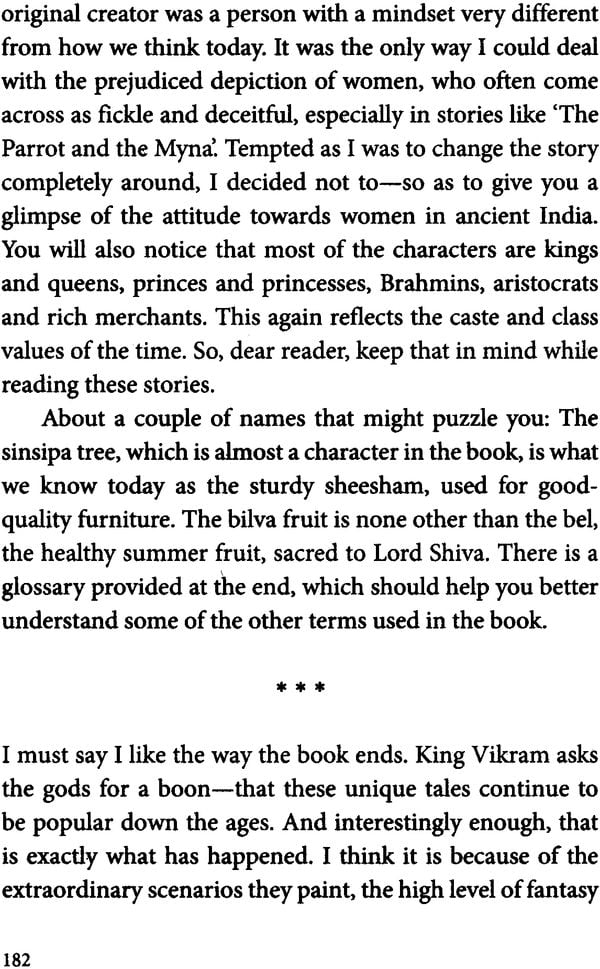
Listen, O King ! (Five and Twenty Tales of Vikram and The Vetal)
Book Specification
| Item Code: | NAL562 |
| Author: | Siva Dasa and Deepa Agrwal |
| Publisher: | Penguin Books |
| Language: | English |
| Edition: | 2016 |
| ISBN: | 9780143333890 |
| Pages: | 208 |
| Cover: | Paperback |
| Other Details | 7.0 inch X 5.0 inch |
| Weight | 140 gm |
Book Description
In a land of glorious kings, bloodthirsty demons and talking spirits was born the lore of Vikram and the vetal. After a series of mysterious events, king Vikramaditya carries the vetal, a witty ghost, on long journey through death's playground. The vetal narrates the most fascinating stories and asks the most puzzling riddles, leaving Vikram completely stumped.
An ascetic who brings his beloved back from the dead, a giant bird that journeys to the underworld to fetch the elixir of life, a servant who sacrifices his life for his ruler, and a woman too beautiful to marry a king are some of the amazing characters that await you within these pages.
Deepa Agarwal's beautiful adaptation brings age-old wisdom alive through the vetal's wondrous tales of glory, love and honour that are bound to captivate and confound readers even today.
Who was Sivadasa?
Nothing is known about Sivadasa, other than the back that this particular work dates back to the twelfth or thirteenth century. In fact, Sivadasa could even be a name. Chandra Rajan, who translated his version of the Vikram-vetal tales from Sanskrit into English, has noted that clues to his personality can be found in his writing. His stories reveal that Sivadasa must have been a learned man, who possessed knowledge in fields as varied as astrology, medicine, the dramatic arts and religion. His readers would most likely have been cultured and sophisticated gentlemen, with an interest in the arts. And since we now education was restricted to the privileged few, they had to be wealthy and well placed too. He must have also been a man who had a clear of right and wrong, which is why there is a great stress on moral values in these tales.
Author, poet and translator, Deepa Agarwal wites for both children and adults and has over fifty books published. A frequent contributor to magazines and journals in India and abroad, she has edited and compiled several anthologies. She has won many prestigious awards, including the NCERT National Award for Children's Litrature in 1993. Her book Caravan to Tibet wan on the IBBY (International Board on Books for Young People) Honour List 2008.
Her work has been translated into several Indian and foreign languages, and five of her books have been included in the White Raven catalogue of the International Youth Library, Munich.
As a resource person for Scholastic India and the National Book Trust, India, among other organizations, she conducts creative-writing workshops and storytelling sessions in schools.
We know little about King Vikramaditya. 'Vikramaditya' is a title, rather than a name. It means: someone whose valour is like that of the sun. There are emperors who have assumed the title of Vikramaditya-Chandragupta II being an example. But there was also a legendary King Vikramaditya, and scholars do not agree about identifying this legendary King Vikramaditya with any one of the known historical King Vikaramdityas.
If you ever visit Ujjain, this illustrious ruler is present 3everywhere, irrespective of which historical Vikramaditya he is identified with. You will be shown temples built by King Vikramaditya. You will be shown the hill where Vikramaditya's throne was buried until King Bhoja discovered it in the eleventh century. Thereby hangs a tale.
Whoever ascended that hill was suffused with immeasurable wisdom. This trait manifested itself in some young cowherds. When this was reported to King Bhoja, he had the hill excavated, and a magnificent throne was discovered; it had thirty-two statuettes. When King Bhoja wisdom to be seated on the throne, the statuettes restrained him. He was told, 'This is Kind Vikramaditya's throne He was a phenomenally wise and great king. To be seated on the throne, you must be as wise as him.' Then, one by one, the thirty-two statuette (each of which was a cursed apsara) told a story about King Vikramaditya's wisdom. These stories are collectively known as the simhasana Dvatrimsika, or Singhasan Battisi. The earliest versions of this text go back to the thirteenth or fourteenth centuries.
The use of the word 'version' is important. There was no printing at the time, and written rendering came much later. Stories were passed down by word of mouth, preserved through oral transmission Consequently, even though there may have been a common origin, there were regional versions and variations. This true of the Simhasana Dvatrimsika, as well as of another text associated with the legendary King Vikramadirya- that is the one wonderfully adapted in this book.
This text is known as the Vetala Panchavimshati, or Baital Pachisi. A vetal is a demon or spirit, almost always male. But it isn't any arbitrary demon or spirit. Specifically, it is a demon that possesses a dead body with an ulterior motive. This text, has twenty-five stories about the vetal, more accurately, stories about the vetal and King Vikramaditya. Each story has a puzzle, and King Vikramaditya has to solve the puzzle. And it is not as if the solutions are easy.
While in the Simhasana Dvatrimsika, King Vikramaditya is depicted as a historical figure, whom King Bhoja hears about from the statuettes, the Vetala Panchavimshati has King Vikramaditya as the primary protagonist. As a text, the Vetala Panchavimshati is also older than the Simhasana Dvatrimsika. The note on the text gives a very good introduction to its antecedents. Indeed, the roots probably go back further still.
There was a text known as the Brihatkatha, dated around the sixth century and attributed to Guadhya. It was not written in Sanskrit, but in a language known as Paishachi. Evidentl, there is no one around who can speak, understand or read Paishachi any longer. The Brihatkatha can loosely be translated as a large collection of stories.
The Brithatkatha didn't survive, but its derivatives did-those stories were passed down through the ages, and featured King Vikramaditya. They were retold in Sanskrit by Kshemendra and Somadeva. There is a version in Nepal, in Sanskrit, a version in old Maharashtrian prose, another in old Tamil verse. All these derivative stories are based on King Vikramaditya, and not on the Vetala Panchavimshati alone. At one point, Kashmir had a rich heritage of works in Sanskrit. And following from this tradition, there are two Sanskrit versions that specifically narrate the Vetala Panchavimshati. These were written by Sivadasa and Jambhaladatta. Both these texts have been translated into English. As the note on the text later mentions, this adaptation is based on Chandra Rajan's translation of the Sivadasa rendering. There are twenty-eight stories, not twenty-five, but the note at the end explains why.
I hope you will read the Simhasana Dvatrimsika some day, too. For some reason-perhaps because of the vetal or because there are engaging riddles-young people love the Vetal Panchavimshati much more. Actually, everyone seems to like the Vetala Panchavimshati more. Therefore, despite it having been translated in the past, what's wrong with another adaptation, especially one directed at the young? Enjoy the stories, they are wonderful! By the way, the sinsipa tree (the Indian rosewood) also figures in the Buddha's discourses. Once you grow up and have the time and the inclination, I hope you read them in the original Sanskrit too.
| Introduction | vii | |
| 1 | How It All Began | 1 |
| 2 | The Ascetic's Visit | 13 |
| 3 | The Mysterious Messages | 20 |
| 4 | The Most Deserving Suitor | 31 |
| 5 | The Parrot and the Myna | 35 |
| 6 | The Devoted Servant | 44 |
| 7 | Who Should Marry Mahadevi? | 52 |
| 8 | Mixed-Up Heads | 58 |
| 9 | The Right Man | 63 |
| 10 | King Gunadhipa's Gratitude | 67 |
| 11 | Madanasena's Promise | 73 |
| 12 | Three Delicate Queens | 78 |
| 13 | The Girl on the Wishing Tree | 81 |
| 14 | Who Is Guity? | 89 |
| 15 | The Girl Wh Wanted to Marry a Robber | 93 |
| 16 | Two Magic Balls | 99 |
| 17 | Jimutavahana's Sacrifice | 110 |
| 18 | Fatal Beautyy | 122 |
| 19 | The Unwise Yogi | 128 |
| 20 | Who Is Prince Haridatta's Real Father? | 134 |
| 21 | The Body Who Laughed | 141 |
| 22 | The Star-Crossed Lovers | 147 |
| 23 | Four Foolish Brhmins | 151 |
| 24 | The Yogi Who Switched Bodies | 155 |
| 25 | The Three Fastidious Brahmins | 158 |
| 26 | A Baffling Relationship | 166 |
| 27 | The Vetal's Revelation | 171 |
| 28 | Epilogue: The Last Riddle | 175 |
| A Note on the Text | 177 | |
| Classic Plus | 185 |


